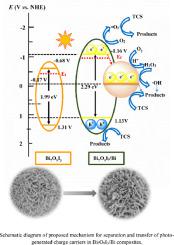Journal of the Taiwan Institute of Chemical Engineers ( IF 5.5 ) Pub Date : 2021-06-19 , DOI: 10.1016/j.jtice.2021.06.014 Chun Chang , Huanchun Yang , Li Kan , Weina Mu , Qiong Wang , Shih-Yuan Lu , Baole Deng

|
Background
Triclosan, a broad-spectrum bacteriostatic germicide, is widely used in daily life. Traditional methods for removal of triclosan however suffer from possible secondary pollution. Photocatalytic technology is considered one of the most promising methods because of its low cost and high efficiencies, which removes pollutants through direct utilization of solar energy.
Methods
Here, a heterostructured composite photocatalyst Bi7O9I3/Bi was prepared through an in situ reduction method for photocatalytic degradation of triclosan, with the degradation mechanism investigated with a free radical trapping experiment and an electron spin resonance (ESR) method. Furthermore, the effects of the presence of inorganic ions on the degradation efficiencies were investigated.
Findings
Compared with Bi7O9I3, the degradation efficiency of Bi7O9I3/Bi on triclosan was significantly improved. This is mainly attributed to the formation of Bi nanoparticles on the surface of Bi7O9I3, which effectively promotes the light absorption through surface plasmon effects of Bi and separation of photo-generated electron-hole pairs through band structure modulation, thereby greatly improving the photocatalytic performances. The photo-generated electrons (e−) and superoxide radicals (·O2−) were found to be the main active species for triclosan degradation. Furthermore, the presence of NO3−, SO42- and Cl− all hamper the photodegradation of triclosan, whereas HCO3−, Ca2+ and Mg2+ inhibit or promote it depending on their concentrations.
中文翻译:

添加无机离子对异质结构Bi7O9I3/Bi光催化降解三氯生的机理及影响
背景
三氯生是一种广谱抑菌杀菌剂,在日常生活中应用广泛。然而,去除三氯生的传统方法存在可能的二次污染。光催化技术通过直接利用太阳能去除污染物,成本低、效率高,被认为是最有前途的方法之一。
方法
在这里,通过原位还原法制备异质结构复合光催化剂Bi 7 O 9 I 3 /Bi 用于光催化降解三氯生,并通过自由基捕获实验和电子自旋共振(ESR)方法研究了降解机理。此外,还研究了无机离子的存在对降解效率的影响。
发现
与Bi 7 O 9 I 3相比,Bi 7 O 9 I 3 /Bi对三氯生的降解效率显着提高。这主要是由于在Bi 7 O 9 I 3表面形成了Bi纳米颗粒,通过Bi的表面等离子体效应有效地促进了光吸收,并通过能带结构调制有效地促进了光生电子-空穴对的分离,从而大大提高提高光催化性能。光生电子 ( e - ) 和超氧自由基 (·O 2 -) 被发现是三氯生降解的主要活性物质。此外,NO 3 -、SO 4 2-和Cl - 的存在都阻碍了三氯生的光降解,而HCO 3 -、Ca 2+和Mg 2+根据它们的浓度抑制或促进它。











































 京公网安备 11010802027423号
京公网安备 11010802027423号